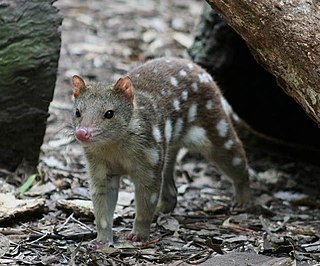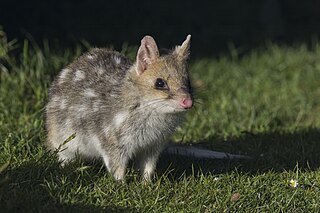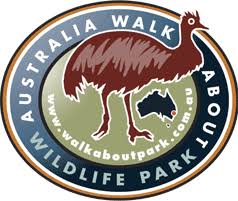Related Research Articles

The thylacine, also commonly known as the Tasmanian tiger or Tasmanian wolf, is an extinct carnivorous marsupial that was native to the Australian mainland and the islands of Tasmania and New Guinea. The thylacine died out in New Guinea and mainland Australia around 3,600–3,200 years ago, prior to the arrival of Europeans, possibly because of the introduction of the dingo, whose earliest record dates to around the same time, but which never reached Tasmania. Prior to European settlement, around 5,000 remained in the wild on Tasmania. Beginning in the nineteenth century, they were perceived as a threat to the livestock of farmers and bounty hunting was introduced. The last known of its species died in 1936 at Hobart Zoo in Tasmania. The thylacine is widespread in popular culture and is a cultural icon in Australia.

The Tasmanian devil is a carnivorous marsupial of the family Dasyuridae. It was formerly present across mainland Australia, but became extinct there around 3,500 years ago; it is now confined to the island of Tasmania. The size of a small dog, the Tasmanian devil became the largest carnivorous marsupial in the world following the extinction of the thylacine in 1936. It is related to quolls, and distantly related to the thylacine. It is characterised by its stocky and muscular build, black fur, pungent odour, extremely loud and disturbing screech, keen sense of smell, and ferocity when feeding. The Tasmanian devil's large head and neck allow it to generate among the strongest bites per unit body mass of any extant predatory land mammal. It hunts prey and scavenges on carrion.

The red-necked wallaby or Bennett's wallaby is a medium-sized macropod marsupial (wallaby), common in the more temperate and fertile parts of eastern Australia, including Tasmania. Red-necked wallabies have been introduced to several other countries, including New Zealand, the United Kingdom, Ireland, the Isle of Man, France and Germany.

Pademelons are small marsupials in the genus Thylogale, found in Australia and Aru, Kai plus New Guinea islands. They are some of the smallest members of the macropod family, which includes the similar-looking but larger kangaroos and wallabies. Pademelons are distinguished by their small size and their short, thick, and sparsely-haired tails. Like other marsupials, they carry their young in a pouch.

The tiger quoll, also known as the spotted-tailed quoll, spotted quoll, spotted-tailed dasyure, or tiger cat, is a carnivorous marsupial of the quoll genus Dasyurus native to Australia. With males and females weighing around 3.5 and 1.8 kg, respectively, it is the world's second-largest extant carnivorous marsupial, behind the Tasmanian devil. Two subspecies are recognised; the nominate is found in wet forests of southeastern Australia and Tasmania, and a northern subspecies, D. m. gracilis, is found in a small area of northern Queensland and is endangered.

Quolls are carnivorous marsupials native to Australia and New Guinea. They are primarily nocturnal and spend most of the day in a den. Of the six species of quoll, four are found in Australia and two in New Guinea. Another two species are known from fossil remains in Pliocene and Pleistocene deposits in Queensland. Genetic evidence indicates that quolls evolved around 15 million years ago in the Miocene, and that the ancestors of the six species had all diverged by around four million years ago. The six species vary in weight and size, from 300 g (11 oz) to 7 kg (15 lb). They have brown or black fur and pink noses. They are largely solitary, but come together for a few social interactions such as mating which occurs during the winter season. A female gives birth to up to 30 pups, but the number that can be raised to adulthood is limited by the number of teats (6–7). They have a life span of 1–5 years.
David Howells Fleay was an Australian scientist and biologist who pioneered the captive breeding of endangered species, and was the first person to breed the platypus in captivity.

Devil facial tumour disease (DFTD) is an aggressive non-viral clonally transmissible cancer which affects Tasmanian devils, a marsupial native to the Australian island of Tasmania. The cancer manifests itself as lumps of soft and ulcerating tissue around the mouth, which may invade surrounding organs and metastasise to other parts of the body. Severe genetic abnormalities exist in cancer cells—for example, DFT2 cells are tetraploid, containing twice as much genetic material as normal cells. DFTD is most often spread by bites, when teeth come into contact with cancer cells; less important pathways of transmission are ingesting of infected carcasses and sharing of food. Adult Tasmanian devils who are otherwise the fittest are most susceptible to the disease.

The eastern quoll is a medium-sized carnivorous marsupial (dasyurid), and one of six extant species of quolls. Endemic to Australia, they occur on the island state of Tasmania, but were considered extinct on the mainland after 1963. The species has been reintroduced to fox-proof fenced sanctuaries in Victoria in 2003 and to the Australian Capital Territory in 2016.

The Tasmanian pademelon, also known as the rufous-bellied pademelon or red-bellied pademelon, is the sole species of pademelon found in Tasmania, and was formerly found throughout southeastern Australia. This pademelon has developed heavier and bushier fur than its northern relatives, which inhabit northern Australia and Papua New Guinea.

Barrington Tops is part of the Great Dividing Range in New South Wales, Australia, between Gloucester and Scone.

The western quoll is Western Australia's largest endemic mammalian carnivore. One of the many marsupial mammals native to Australia, it is also known as the chuditch. The species is currently classed as near-threatened.

The Australian Reptile Park is located at Somersby on the Central Coast of New South Wales, Australia. It is about 71 kilometres (44 mi) north of Sydney, and is just off the M1 Pacific Motorway, near Gosford. The Park has one of the largest reptile collections in Australia, with close to 50 species on display. The wide variety of reptile species at the Park includes snakes, lizards, turtles, tortoises, tuataras, American alligators and crocodiles.

Moonlit Sanctuary Wildlife Conservation Park is a 25-acre (10 ha) biopark within the Pearcedale Conservation Park located at Pearcedale on the Mornington Peninsula near Melbourne, Australia. It aims to display the fauna that was found in the Mornington Peninsula and Western Port Biosphere Reserve prior to European settlement as well as working towards the recovery of threatened Australian fauna. The park is open all year except on Christmas Day. The sanctuary, as part of Pearcedale Conservation Park, is an institutional member of the Zoo and Aquarium Association (ZAA). It is ECO Certified at the Ecotourism level by Ecotourism Australia.

Tasmania Zoo is a zoo located in Launceston, in the Australian state of Tasmania. Situated on 900 acres (360 ha) of old growth native bushland, it is home to the state's largest collection of native and exotic animals. Tasmania Zoo is a fully accredited member of the Zoo and Aquarium Association, working closely with all Australasian zoos, and are involved in various species management programs.

Mulligans Flat Woodland Sanctuary is a protected area situated in the Gungahlin district in north Canberra in the Australian Capital Territory. It has several trails for walking, running and cycling. The sanctuary functions as a fieldwork site for researchers studying native ecology.

The Ballarat Wildlife Park is a wildlife park in Ballarat, Victoria. Opened in February 1985, it is privately owned by founder Greg Parker, Stuart Parker and Julia Leonard. The 10-hectare park holds over 300 animals, including Australian animals—there are over 100 free-roaming kangaroos—and an extensive collection of reptiles. It was once well known for housing Patrick, the common wombat who was the oldest known marsupial in captivity when he died aged around 30 years old in 2017.

Featherdale Wildlife Park is a zoo located in Doonside, Sydney, Australia. The park is located in Sydney's west, approximately 40 km (25 mi) from Sydney's CBD. The park contains various species native to Australia, and is known to be one of the world's largest collections of Australian fauna. The facility provides displays, events and interactive experiences. The site covers 3.29 hectares, ranging from animal enclosures and display areas to visitor facilities, including picnic spaces, shops and basic amenities. It specialises in Australian native wildlife and birds, as well as reptiles and marsupials. The premises is accredited by the Zoo Aquarium Association Australia.
Ranger Red's Zoo and Conservation Park, formerly Peel Zoo, is a zoo and wildlife sanctuary located on the banks of the Murray River in Pinjarra, Western Australia. It is a member of the Zoo and Aquarium Association.

Australia Walkabout Wildlife Park is a wildlife sanctuary located in Calga, New South Wales, Australia. The wildlife park is home to Australian native birds, mammals and reptiles as well as farm animals. It offers research and education programs, with visitors able to undertake day and night tours. The park is home to a wide range of Australian animals and in 2021 became home to a group of meerkats, the park's first exotic animals.
References
- 1 2 "Devil Ark: saving Tasmanian devils". Australian Geographic. 5 March 2014. Retrieved 26 October 2014.
- ↑ "How Devil Ark come into being". Devil Ark. Archived from the original on 26 October 2014. Retrieved 26 October 2014.
- 1 2 Siossian, Emma (10 November 2022). "Record numbers of eastern quoll joeys born at Barrington Wildlife Sanctuary". ABC News. Retrieved 11 November 2022.
- ↑ "Barrington Tops Devil Ark preparing to open to the public as an exclusive wildlife attraction". The Daily Telegraph . 15 November 2013. Retrieved 26 October 2014.
- ↑ "PROJECTS". Aussie Ark. Retrieved 7 October 2020.
- ↑ "Tasmanian devils return to mainland Australia for first time in 3,000 years". Animals. 5 October 2020. Archived from the original on 6 October 2020. Retrieved 7 October 2020.